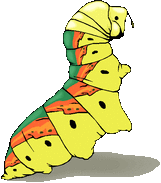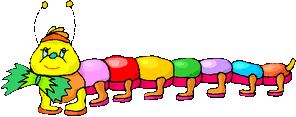
Trial Flu Vaccine Produced From Caterpillar Cells
May 4, 2004
By WILLIAM HATHAWAY, Courant Staff Writer
To fight rapidly changing flu viruses, a vaccine needs to be produced fast - and faster than the current yearly dash involving tens of millions of fertilized eggs. A local Meriden company that uses caterpillar cells to make a new brand of influenza vaccine has taken a big step in that direction. Last week Protein Sciences Corp. announced its vaccine protects more elderly people from influenza than existing vaccines made in chicken eggs, according to trial results.
Because the new vaccine is not cultivated in eggs, it can be produced quickly enough to protect people against rapidly emerging strains of influenza, said Daniel Adams, president and chief executive of Protein Sciences Corp., developer of the vaccine. Last winter, the Fujian variant of influenza sickened thousands of people who received flu shots that primarily protected them against a different strain of the flu.
"In theory, we can save a lot of lives," Adams said.
Infectious disease experts have long warned that the approximately eight-month lead time needed to manufacture today's egg-based flu vaccines makes the world vulnerable to wily new flu strains as well as new viruses such as SARS, or severe acute respiratory syndrome. Also, new strains of deadly avian flu destroy fertilized eggs, making current vaccine technology useless in case of an outbreak of bird flu.
"If something happens to offset the timeline of vaccine production, the downstream consequences can be great," said Dr. Linda Lambert, influenza program officer for the National Institute of Allergy and Infectious Diseases, part of the National Institutes of Health. That's why the federal government is encouraging companies such as Protein Sciences to develop new ways to make vaccines, Lambert said. Protein Sciences is one of several companies using new technologies to create egg-less vaccines that can combat both influenza and SARS.
Phase II trials of the new FluBlØk vaccine showed no major safety problems in 400 people over age 64 who were tested, according to the trial results. At the highest doses tested, the vaccine triggered antibody responses in about twice as many subjects as the current licensed vaccine made by Aventis.
At the highest dose of FluBlØk, 97 percent of the subjects tested produced an antibody response thought to be strong enough to protect them against the flu. Influenza kills between 20,000 and 50,000 people annually. About 90 percent of the fatalities are among the elderly. That means thousands of U.S. lives could potentially be saved by the new vaccine, Adams said. Adams said that Phase III trials of the vaccine would start in the fall. The results of the trial will be evaluated by the spring of 2005. If the trial is successful, a new vaccine could be on the market the following flu season.
Instead of eggs, the FluBlØk vaccine is made by replicating parts of the influenza virus' RNA in caterpillar cells. Other researchers are trying different approaches, such as using snippets of viral DNA in flu vaccines. But, Lambert said, among the new technologies being tested to create new vaccines, those that rely on culturing the virus in animal cells are closest to hitting the marketplace. Monkey, dog and human cells are being used by other companies in their own recombinant vaccines.
But, said Adams, "those [cell] systems have a much higher cost" than the process his company is using with caterpillar cells. "Our costs are about the same as egg-based vaccines and are safer." Unlike mammalian cells, Adams said, insect cells do not harbor other viruses that may contaminate vaccines. "If you are making a vaccine for humans, why not use human cells?" countered Thomas Redington, a spokesman for Crucell NV, a Netherlands-based biotech company seeking to do just that. Aventis already has invested in Crucell's effort to develop a human-cell-based flu vaccine, which has not yet entered clinical trials.
Whatever medium is used, the world will be better off with an alternative to the mad and messy scramble of making vaccines from eggs. "The good news for everybody is the industry is moving toward pharmaceutical quality manufacturing for flu vaccines," Redington said.
May 4, 2004
By WILLIAM HATHAWAY, Courant Staff Writer
To fight rapidly changing flu viruses, a vaccine needs to be produced fast - and faster than the current yearly dash involving tens of millions of fertilized eggs. A local Meriden company that uses caterpillar cells to make a new brand of influenza vaccine has taken a big step in that direction. Last week Protein Sciences Corp. announced its vaccine protects more elderly people from influenza than existing vaccines made in chicken eggs, according to trial results.
Because the new vaccine is not cultivated in eggs, it can be produced quickly enough to protect people against rapidly emerging strains of influenza, said Daniel Adams, president and chief executive of Protein Sciences Corp., developer of the vaccine. Last winter, the Fujian variant of influenza sickened thousands of people who received flu shots that primarily protected them against a different strain of the flu.
"In theory, we can save a lot of lives," Adams said.
Infectious disease experts have long warned that the approximately eight-month lead time needed to manufacture today's egg-based flu vaccines makes the world vulnerable to wily new flu strains as well as new viruses such as SARS, or severe acute respiratory syndrome. Also, new strains of deadly avian flu destroy fertilized eggs, making current vaccine technology useless in case of an outbreak of bird flu.
"If something happens to offset the timeline of vaccine production, the downstream consequences can be great," said Dr. Linda Lambert, influenza program officer for the National Institute of Allergy and Infectious Diseases, part of the National Institutes of Health. That's why the federal government is encouraging companies such as Protein Sciences to develop new ways to make vaccines, Lambert said. Protein Sciences is one of several companies using new technologies to create egg-less vaccines that can combat both influenza and SARS.
Phase II trials of the new FluBlØk vaccine showed no major safety problems in 400 people over age 64 who were tested, according to the trial results. At the highest doses tested, the vaccine triggered antibody responses in about twice as many subjects as the current licensed vaccine made by Aventis.
At the highest dose of FluBlØk, 97 percent of the subjects tested produced an antibody response thought to be strong enough to protect them against the flu. Influenza kills between 20,000 and 50,000 people annually. About 90 percent of the fatalities are among the elderly. That means thousands of U.S. lives could potentially be saved by the new vaccine, Adams said. Adams said that Phase III trials of the vaccine would start in the fall. The results of the trial will be evaluated by the spring of 2005. If the trial is successful, a new vaccine could be on the market the following flu season.
Instead of eggs, the FluBlØk vaccine is made by replicating parts of the influenza virus' RNA in caterpillar cells. Other researchers are trying different approaches, such as using snippets of viral DNA in flu vaccines. But, Lambert said, among the new technologies being tested to create new vaccines, those that rely on culturing the virus in animal cells are closest to hitting the marketplace. Monkey, dog and human cells are being used by other companies in their own recombinant vaccines.
But, said Adams, "those [cell] systems have a much higher cost" than the process his company is using with caterpillar cells. "Our costs are about the same as egg-based vaccines and are safer." Unlike mammalian cells, Adams said, insect cells do not harbor other viruses that may contaminate vaccines. "If you are making a vaccine for humans, why not use human cells?" countered Thomas Redington, a spokesman for Crucell NV, a Netherlands-based biotech company seeking to do just that. Aventis already has invested in Crucell's effort to develop a human-cell-based flu vaccine, which has not yet entered clinical trials.
Whatever medium is used, the world will be better off with an alternative to the mad and messy scramble of making vaccines from eggs. "The good news for everybody is the industry is moving toward pharmaceutical quality manufacturing for flu vaccines," Redington said.

Vaccine. 2005 Apr 22;23(22):2943-52. Related Articles, Links
Generation of influenza vaccine viruses on Vero cells by reverse genetics: an H5N1 candidate vaccine strain produced under a quality system.
Nicolson C, Major D, Wood JM, Robertson JS.
Division of Virology, National Institute for Biological Standards and Control, South Mimms, Potters Bar, Herts EN6 3QG, UK.
Human influenza vaccine reference strains are prepared as required when an antigenically new strain is recommended by WHO for inclusion in the vaccine. Currently, for influenza A, these strains are produced by a double infection of embryonated hens' eggs using the recommended strain and the laboratory strain PR8 which grows to high titre in eggs, in order to produce a high growth reassortant (HGR). HGRs are provided by WHO reference laboratories to the vaccine manufacturing industry which use them to prepare seed virus for vaccine production. The use of reverse genetics in preparing vaccine reference strains offers several advantages over the traditional method: (i) the reverse genetics approach is a direct rational approach compared with the potentially hit-or-miss traditional approach; (ii) reverse genetics will decontaminate a wild type virus that may have been derived in a non-validated system, e.g. a cell line not validated for vaccine purposes, or that may contain additional pathogens; (iii) at the plasmid stage, the HA can be engineered to remove pathogenic traits. The use of reverse genetics in deriving HGRs has been demonstrated by several laboratories, including its use in deriving a non-pathogenic reassortant strain from a highly pathogenic virus. In this report, we have advanced the use of reverse genetics by making use of a cell line acceptable for human vaccine production, by demonstrating directly the short time frame in which a reassortant virus can be derived, and by deriving a non-pathogenic pandemic vaccine reference virus in cells validated for vaccine production and under quality controlled conditions.
PMID: 15780743 [PubMed - in process]
Generation of influenza vaccine viruses on Vero cells by reverse genetics: an H5N1 candidate vaccine strain produced under a quality system.
Nicolson C, Major D, Wood JM, Robertson JS.
Division of Virology, National Institute for Biological Standards and Control, South Mimms, Potters Bar, Herts EN6 3QG, UK.
Human influenza vaccine reference strains are prepared as required when an antigenically new strain is recommended by WHO for inclusion in the vaccine. Currently, for influenza A, these strains are produced by a double infection of embryonated hens' eggs using the recommended strain and the laboratory strain PR8 which grows to high titre in eggs, in order to produce a high growth reassortant (HGR). HGRs are provided by WHO reference laboratories to the vaccine manufacturing industry which use them to prepare seed virus for vaccine production. The use of reverse genetics in preparing vaccine reference strains offers several advantages over the traditional method: (i) the reverse genetics approach is a direct rational approach compared with the potentially hit-or-miss traditional approach; (ii) reverse genetics will decontaminate a wild type virus that may have been derived in a non-validated system, e.g. a cell line not validated for vaccine purposes, or that may contain additional pathogens; (iii) at the plasmid stage, the HA can be engineered to remove pathogenic traits. The use of reverse genetics in deriving HGRs has been demonstrated by several laboratories, including its use in deriving a non-pathogenic reassortant strain from a highly pathogenic virus. In this report, we have advanced the use of reverse genetics by making use of a cell line acceptable for human vaccine production, by demonstrating directly the short time frame in which a reassortant virus can be derived, and by deriving a non-pathogenic pandemic vaccine reference virus in cells validated for vaccine production and under quality controlled conditions.
PMID: 15780743 [PubMed - in process]
